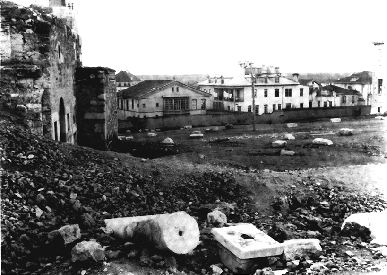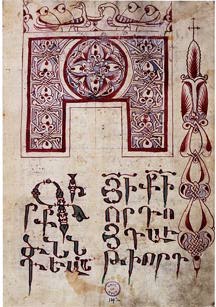
Of all the time Kelsey spent in Turkey, his shortest stay was in the south, in Cilicia. However, he expended a great amount of time and energy on behalf of the Christian communities there, which were, largely, Armenian. In Cilicia, as elsewhere, he collected artifacts and photographed monuments of its ancient and mediaeval past, its modern inhabitants and examples of the Western presence--missionaries, schools, and relief efforts. Kelsey's archaeological interests in Cilicia paralleled his interests in other regions he surveyed during this expedition. He travelled to modern towns as well as to ancient sites. In his search for evidence of daily life and death as it spanned the centuries, he had the exbedition photographer document the changing countryside, people at work, "ethnological types," churches, cemeteries, etc. Contributing to the intensification of Kelsey's efforts on behalf of the Armenians of Cilicia were a series of violent incidents which occurred during the expedition.
MAP: Greater ArmeniaCilicia and Greater Armenia
Long before its foundations as Greater Armenia, the region surrounding Lake Van and Mount Ararat had been a point of cultural contact for the ancient Near East. Anatolian, Indo-European and other migratory tribes converged here with the local Urartian population. After the collapse of the Urartian kingdom toward the end of the 7th century B.C. the new ethnico-political entity of Armenia began to emerge. The first independent Armenian dynasty claimed its independence from the rule of the Greek Seleucids only in the 2nd century B.C. Throughout the later history of Greater Armenia various local and foreign powers sought to dominate its main resource, which was the northern trade route across Asia Minor. Armenians maintained a precarious, limited and often interrupted control only by the prudent political powers. In the 11th century, as the Seljuk Turks routed the Byzantines and won governance of Greater Armenia, the Byzantines sought to protect their dwindling territory by relocating Armenians to the province of Cilicia.
MAP: Cilicia
Armenians settled in the mountains and valleys of Cilicia and there established the last independent Armenian kingdom of the middle ages. Architectural monuments and other artifacts testify to the three-hundred-year flowering of the Cilician Kingdom of Lesser Armenia. Located at the easternmost corner of the Mediterranean, in fertile agricultural land, on the southern caravan route, and controlling southern access into central Anatolia, Cilicia had always been of great strategic importance to the Near East. From their fortified mountain castles the Armenian barons guarded the passes through Cilicia and controlled the overland trade to and from Asia. This was the source of the kingdom's wealth and its knowledge of East and West. Visitors from all over the known world -- Byzantine Christians, Muslims from the East, and Crusaders from Western Europe on their way to the Holy Land -- passed through Cilicia. Cilician Armenia created its own culture, an interpenetration of Armenian traditions and Byzantine, Islamic and Western influences. Eventually weakened by warfare with its neighbors and invaders, the kingdom fell to the Mamelukes in 1375.
Cilicia became part of the Ottoman Empire in the 15th century, with Armenians maintaining a presence in the trading cities. Along with the Syrian and Greek Christian communities of the empire, Cilician Armenians generally survived and prospered until the beginning of this century. During the Great War, as the Ottoman Empire collapsed, relocation marches drove much of the Armenian community out of the area. Survivors returned to Cilicia under the promise of British and French protection. In 1920, fierce fighting broke out. The Western allies abandoned the military struggle, and the Armenian communities of Cilicia were ultimately driven south to Syria and Lebanon in the winter of 1920. (Many members of the Armenian communities of southeastern Michigan who immigrated from Syria and Lebanon have roots in the region of Cilicia.)
* * *

Gospels written in black ink on paper.
Full page evangelist portraits, ornamented headpieces and marginalia in reds, pinks, blues, oranges and yellows. Bound between wooden boards covered in brown leather and decorated with crosses.
Probably Aleppo, 17-18th c. AC
University of Michigan, Rare Book Room. MS 142.
The changing locations for Armenian life in Asia Minor contributed to a constant cultural core which is reflected in a readily recognizable Armenian artistic style. Ancient arts of the northern and southern regions later inhabited by the Armenian cultures are often cited and collected as precursors to the Armenian artistic tradition. Many of the artistic remains have survived above ground for all to see until the present day and may have provided inspiration for later artistic developments. Moreover, Armenian culture retained a characteristic openness to integrating diverse influences. The influences of Sassanian, Byzantine, Crusader and Mameluke art are clearly discernible in Armenian art of various time periods. Forms, designs, techniques, and imagery often developed from originally foreign repertories, but transformed by Armenian artisans into a vital, unified artistic tradition. Even after the end of the middle ages Armenian works continued to share international trends, as is apparent in the locations of their manufacture, in technology and style.
Christianity defines the chief part of this cultural core. In a way, Armenian culture has no pre-Christian history. King Trdat, the first Armenian Christian king, while engaged in the ancient Near Eastern, particularly Sassanian royal activity of hunting, experienced a vision of the cross of Christ's crucifixion, and converted on the spot. This and other Armenian myths about their conversion to Christianity served to define the people as a Christian community. These tales were written in an alphabet created around the turn of the 5th century A.C. in Edessa, Syria, where the Syriac written language was being shaped concurrently. Armenian literature developed at an enormous rate during the 5th and 6th centuries and incorporated Christian literary traditions of, for example, hagiography (writings about martyrs and saints) and exegesis (scriptural interpretation). Not only Armenian literature but all of Armenian culture developed within the international setting of early Christianity.
Certain artistic forms, however, developed with an intensity unique to Armenia. Mediaeval manuscripts offer a chain of evidence of the determined continuity of Christian Armenian culture despite disruptive changes. The initial letters of chapters and sentences in lavish hand-produced manuscripts were treated to elaborate ornamentation that transformed the letters into plants, figures, animals, abstract patterns and other hybrid creations. A distinctively Armenian style in representational arts is typically vibrant and ornate. No element is merely functional. Frames for scenes, for example, serve as both boundary and ornament. Characteristically, forms of clear, flat colors are outlined in black, then shaded and lightened to white so as to create an effect of shimmering light, agitated energy. Lines, often freed from the simply descriptive, make dynamic abstract patterns of whorls, waves and other almost animate shapes. Improvisations on basic forms are drawn out and repeated with infinite variations: a leaf, for example, may be split into two parts, those parts then reversed, smoothed, lengthened and interlaced.
Khatchkars are a type of carved plaque made only in Armenia, principally for cemetery use, but generally commemorative in function. The earliest khatchkars date from the 9th century A.C., but the form found its greatest expressions in the 13th century. Designs on khatchkars are essentially crosses, often elaborated by the abstract intricately interlaced patterns so often found in other Armenian arts.
Armenian architecture of the middle ages, known to us mainly from the remains of churches and castles, is also distinctive in style. Built of ashlar blocks of local tufa (a volcanic stone, often reddish in hue) over concrete cores, the churches tend to compact geometric masses which rise dramatically from cross-shaped ground-plans to high domes supported by squinches. Cross shapes appear to have functioned as markers of faith since the legendary conversion of King Trdat, and are ubiqitous in Armenian art. Other especially Armenian imagery, based on conversion myths and local history for example, were often incorporated into the more standard Christian compositions based on the Old and New Testaments.
* * *

Ruins of an Armenian church, Konya Turkey
December 29, 1919
Photograph by G. R. Swain
Neg. KS 59-5
* * *
Kelsey's interests in Armenia were very much influenced by his own background as a Christian of Western European descent. Since mediaeval times, Western presences in the region had taken their cues from the status of Christians there. A scenario similar to that played out during the Crusades was re-enacted in the late 19th and early 20th centuries. Western missionaries, chiefly Protestants, looked to ancient Jewish and Christian nations of the Near East as the cradles of modern Christian civilization. The missionaries were followed by Western military might, wielded to control and redistribute Near Eastern territories to the descendents of those ancient nations. Whereas Britain established the state of Israel in Palestine, America's President Wilson drew up an initiative to carve a 20th-century Cilician nation out of Turkish territory.
International political developments were of great interest to Kelsey, but his more successful efforts were on a less grandiose scale. He documented the work of missionaries associated with Near East Relief and the Young Men's Christian Association, American-based missionary organizations that worked to relieve shortages of food as well as to provide food, shelter and professional training to the Armenian survivors of hostilities in Cilicia, as well as to the Christian World War I refugees of Syria and Greece.
* * *
One incident in particular served to highlight the danger and urgency of the situation: two American missionaries and their Syrian driver were ambushed, shot and killed on the road between Aintab and Aleppo. Kelsey had something of a personal stake in the killings of Perry, Johnson and Zakie because Swain had photographed Mr. Perry and other missionaries only weeks before and because Zakie had driven Kelsey and Swain along the same road, again only a few weeks before. Although Kelsey had been quite frightened when travelling that road because of rumors of random violence, his party had passed through safely and had trusted their safety to their identity as Americans. Now that Americans' sense of immunity had been demolished, the direness of local conditions became frighteningly clear.
Tales of siege warfare at the towns of Aintab, Urfa and Marash continued to push Kelsey into action while he remained secure outside the country, his expedition having gone on to Syria and Palestine, and to Egypt. During these latter months of the expedition and after, Kelsaey put together documentary and photographic "exhibits" which recorded these and other incidents of violence directed against missionaries and Armenian communities in the Near East. These he sent to political leaders and high-ranking military personnel as well as to prominent residents of Michigan and the rest of the United States. While his articles and exhibits were published in the local press, University of Michigan and missionary publications, national and international recognition eluded him. His version of these events never found widespread publicity.